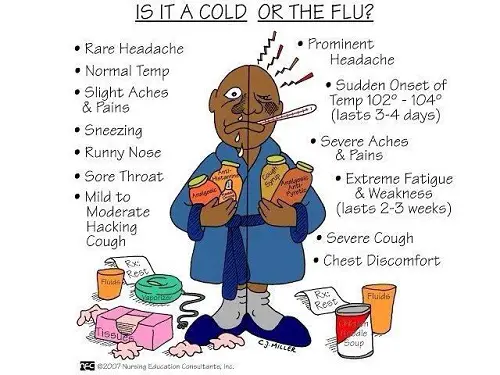Influenza A and influenza B viruses are two of the total four types of Influenza viruses, typically causing similar, flu-like symptoms, and are on the rise in the flu season all across the country, making it an endemic disease.

What is Influenza A?
Influenza A is typically called common flu. It occurs usually around the beginning of all; hence the season is named flu season.
Its genome shows the 8 negative stands of RNA segments.
This virus typically resides in wild birds, hence also called ‘avian flu’ or bird flu.
It can spread from birds to humans, causing an array of symptoms resembling other conditions.
It has two subtypes, H1N1 and H3N2.
The virus like other viruses mutates every year, hence making the flu vaccine ineffective or less effective.
Typical symptoms of the influenza A virus are:
- Runny nose or blocked nose
- Sneezing frequently
- Watery eyes
- Body aches
- Fever with chills
- Mild soreness in the throat
- Mild to severe headache
- Persistent cough
- Severe fatigue and weakness
If it is left untreated or the body is immunocompromised, it can develop into conditions like pneumonia, bronchitis, asthma attack, ear infections, gastrointestinal problems, etc.
In very rare cases, the virus can also prove to be fatal.
Diagnosis is typically made by clinical examination, history, and symptoms.
Your doctor can also take a sample via nasal or throat swab to perform a rapid molecular immunoassay, which can detect the virus within 30 minutes time.
Usually, the symptoms of influenza A resolve on their own when the virus completes its course, between 7-14 days. However, in patients with immunocompromised conditions, doctors can prescribe antiviral drugs like zanamivir, peramivir, or oseltamivir to control the infection.
Keeping hydrated and loosening the mucus in the chest helps in recovery along with OTC medicines like anti-pyretic, anti-histamines, and paracetamol.

What is Influenza B?
Influenza B is morphologically similar to the Influenza A virus; however, there are some unusual differences that make it stand out from Influenza A.
The primary host of influenza B virus (IBV) is humans, however, it can also be found in pigs and seals.
The genome sequence of IVB consists of 6 segments of negative single-stranded RNA.
Recently it has been discovered to have two lineages, IVB Victoria and IVB Yamagata.
Although IVB mutates 2-3 times lesser than IVA, however, it mutates significantly to make the vaccine ineffective or less effective.
It is less severe than IVA but causes almost similar symptoms. The most common symptoms of IVB are fever, chills, and sore throat. Other symptoms are less common but not entirely absent.
Usually, IVB is rendered as uncomplicated flu and does not require any aggressive treatment.
Once the diagnosis is confirmed, it can be treated with OTC medicines like paracetamol, antihistamines, and antipyretics. Hydration is very important in the recovery phase.
Antiviral drugs can be given orally, intravenously, or via inhalation, depending upon the immunity of the patient and age group.
Similarities between Influenza A and Influenza B
Virus Family
Both, Influenza A virus and influenza B virus belong to the Orthomyxovirdae family of viruses.
Genomic Structure
IAV and IBV both have similar genomic structures. They are negative-sense RNA sequence which is single-stranded.
Mutation
Not only do both influenza A and influenza B viruses mutate, but they also replicate and form similar and stranger copies of themselves hence are contagious and hard to prevent.
Symptoms
Common symptoms shown by IAV and IBV are fever, runny nose, sometimes blocked nose, persistent cough, fatigued body, chills, severe headache and body ache, sneezing, watery eyes, and loss of appetite.
Both can develop complications and turn from upper respiratory tract infections into lower respiratory tract infections causing pneumonia, bronchitis, abdominal pain, and cardiac pathologies.
Diagnosis
The test of choice for both influenza viruses is a rapid molecular assay that can give results within 30 minutes by recognizing influenza virus RNA. The sample can be taken as a nasal or throat swab.
Vaccination
Both influenza A and influenza B viruses can be prevented by the quadrivalent influenza (flu) vaccine which is administered annually to everyone above the age of two years. Although mutations can make it hard to prevent, they can shorten the course of the disease.
Treatment options
Hydration, antipyretic, and antihistamines are the primary OTC medicines of choice for both influenza A and B. The virus usually completes its course and recovers through the body’s immune response. Other drugs of choice are zanamivir, oseltamivir, and peramivir.
Complications
If left untreated or in immunocompromized patients, the viruses can progress into asthma attacks, bronchitis, and pneumonia. In rare cases, it can even cause death.
FAQs
Are influenza A and B the same?
Influenza A and influenza B belong to the same group of viruses but show slight differences clinically.
Difference between influenza A and B
Influenza B is milder as compared to influenza A and it mutates 2-3 times lesser as compared to the influenza A virus.
Do flu A and Flu B have different symptoms?
Influenza A and B typically show similar signs and symptoms. They differ only in intensity and duration of symptoms.
What is the most common flu A or B?
Flu A is more common than flu B. because of its rapid rate of mutation, Flu A is more contagious than flu B.
Is it common to have influenza A and B at the same time?
Recently, influenza A and influenza B have been discovered to occur simultaneously in the host. Although the incidents are rare they do occur simultaneously now.
Which flu is stronger A or B?
Influenza A is stronger as compared to influenza B due to its virulence, spread, and mutation rate.
How long does flu type A last?
The symptoms should start getting better in 3-7 days however; the Virus can last in the body for two weeks at most.
Is type-A flu very contagious?
Yes, type-A flu is very contagious as compared to type B or C.
How long does type B flu last?
It lasts for 7 days on average if no complications develop.
Which is milder flu A or B?
Flu B is milder than Flu A.











